Last Updated: 06/05/2025
Fleas on Cat: Everything You Need to Know
Learn everything you need to know about fleas on cats: how they get them how to tell and how to get rid of them.
Author: Dr Carla Paszkowski BVSc (Hons)
Reading Time: 67 minutes - extensive read
Fleas pose a significant threat to your kitty's health. These tiny parasites not only cause discomfort and irritation but can also lead to more serious health issues. Flea bites can result in allergic reactions, causing intense itching and discomfort for cats. Furthermore, fleas are notorious vectors for various diseases and can transmit harmful pathogens to our feline friends.
Prevention is key to safeguarding the health of your cat - routine use of flea prevention measures, such as topical treatments or oral medications, helps maintain a flea-free environment and ensures the overall health of your beloved cat.
In this article, we'll discuss:
6. What to expect after flea treatment
What Are Fleas?
Fleas are small, wingless, bloodsucking insects that live on your cat's body and lay eggs in the surrounding environment. The species that affects cats and dogs is called Ctenocephalides felis felis.
The flea has four life stages: egg, larvae, pupae and adult. Of all these phases, only the adult phase occurs on the host animal (your cat!). Adult fleas can live 100 days on a host animal, and 1-2 weeks without a host animal. Eggs are laid in the environment - particularly in soft warm fabric such as carpets, pet beds, and blankets. That is why it is so hard to get rid of fleas; a new wave of juvenile fleas can emerge after you've killed the initial population with a flea treatment.
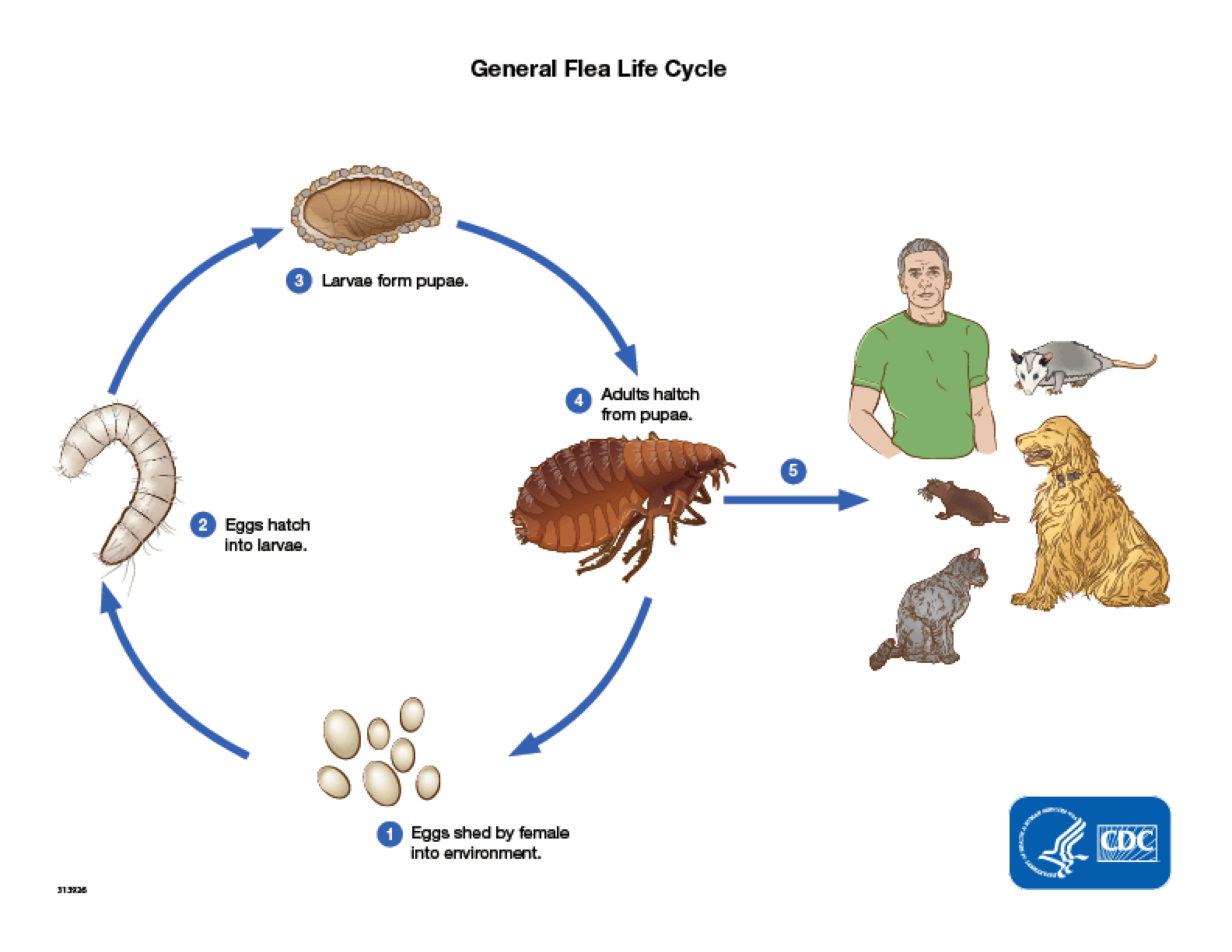
What do fleas look like on cats?
Contrary to what you might think, visualising flea insects crawliing in your pet's fur is not the identifying sign of a flea infestation. Fleas are very small and difficult to see, due to their sneaky ability to weave intricately between your cat's fur shafts. This means that you may never see a single flea on your cat, depite a rampant infestation.
Instead, the visible component of a flea infestation is actually the 'flea dirt', a.k.a. the faeces of the flea, made from digested blood. Flea dirt has a brown, dirt-like appearance (see image) that sits within your pet's fur, and is usually observed most prominently on the chin in cats.
To determine if the dirt in your cat's fur is flea dirt and not just regular dirt, place some on a wet paper towel. If the dirt leaves a red residue on the wet paper, it confirms that it is dried blood and therefore flea dirt.
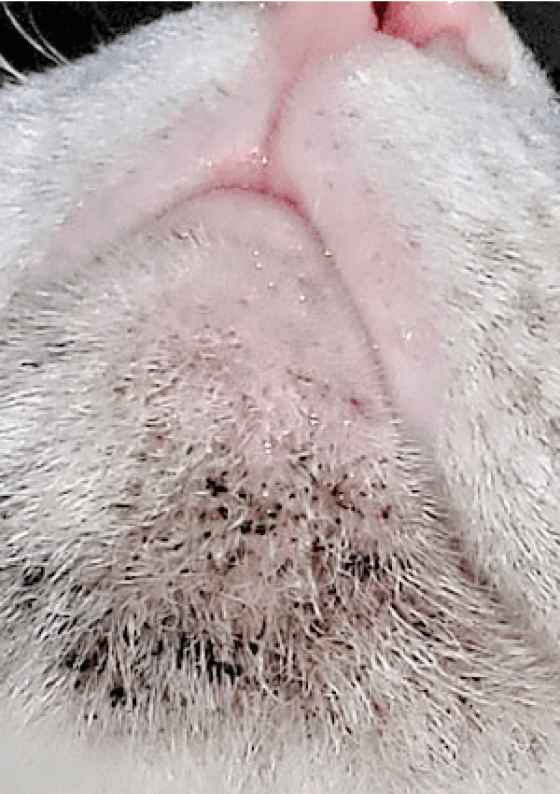
Do dogs and cats have the same fleas?
Yes, despite being commonly known as the 'Cat Flea', both dogs and cats are infected by the Ctenocephalides felis felis species. Its ability to infect different species makes the cat flea particularly difficult to get rid of, as your dog may continuously re-infect your cat, or visa versa. Even wildlife may be a potential source of infection for your kitty.
Symptoms and Risks
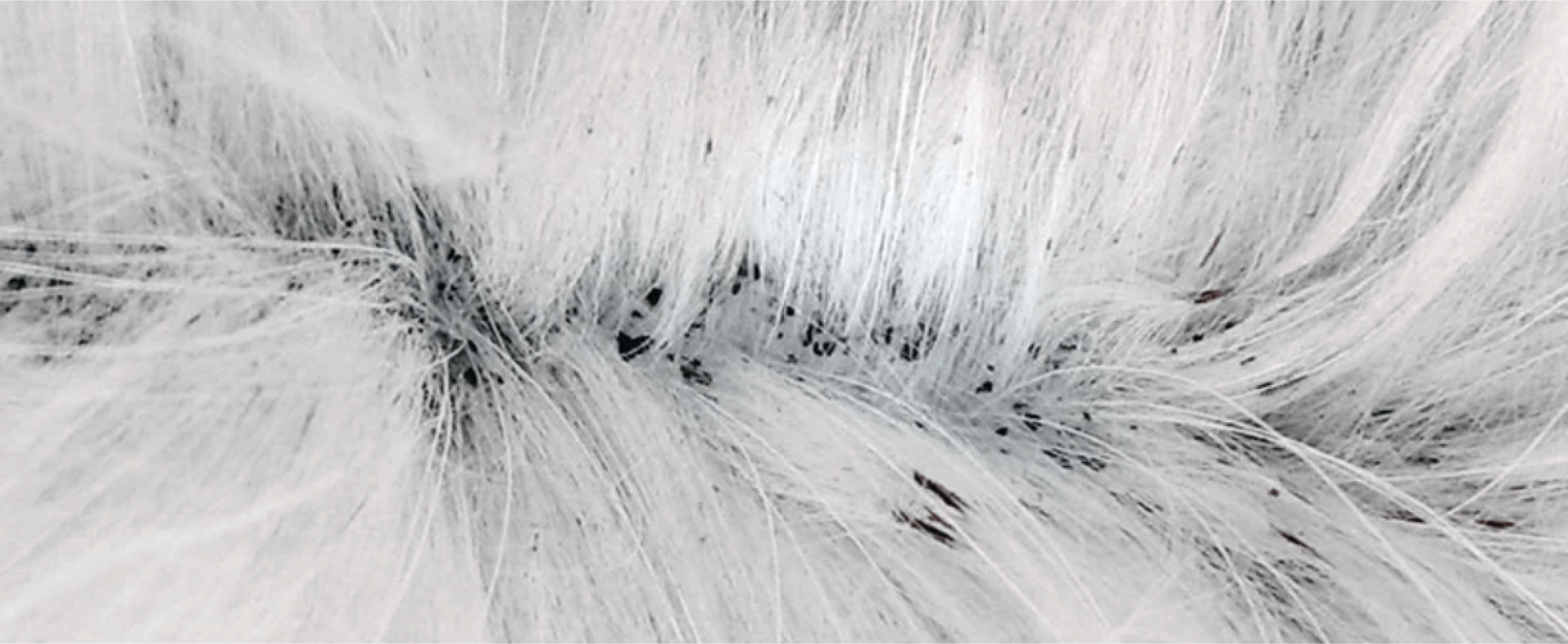
Symptoms of flea infestation
- Scratching (however some cats do not show obvious signs of itchiness from fleas)
- Biting or excessive licking and grooming
- Hair loss, usually secondary to scratching
- Presence of flea dirt, particularly under the chin
- Pale gums and lethargy if anaemia is presen
Secondary Risks to Flea Infestation
Due to their skin-biting and blood-sucking nature, flea infestations can cause a number of secondary issues for your cat. These include allergic dermatitis, anaemia due to blood loss, transmission of tapeworm, and other diseases.
How Do Cats Catch Fleas?
There are many ways your cat may have caught fleas. The first and most obvious way is by contacting other cats, dogs, or wildlife. If your cat has access to the outdoors, they will be in contact with other animals all the time - even if you don't see it!
However, indoor cats can also catch fleas from sources listed below.
How Indoor Cats Cat Fleas
- Humans as flea carriers
- Other pets
- Trips to places such as the vet, groomer, or daycare
- New homes and new furniture
Factors that can increase your cat's risk of catching fleas may include another pet in the house (particularly one who has not been treated for fleas), visiting dogs or stray cats, pests such as rats and mice, and exposure to the outdoors.
Read more in our article How Do Cats Get Fleas?
Diagnosis
Due to the difficulty of seeing the fleas themselves, flea infestations are usually diagnosed by:
• Using a specialised flea comb - this can help pick up fleas and flea dirt from your cat's fur
If you aren't sure whether the dirt retrieved from the flea comb is flea dirt or just regular dirt, place some on a wet paper towel. If the dirt leaves a red residue on the wet paper, it confirms that it is dried blood and therefore flea dirt.
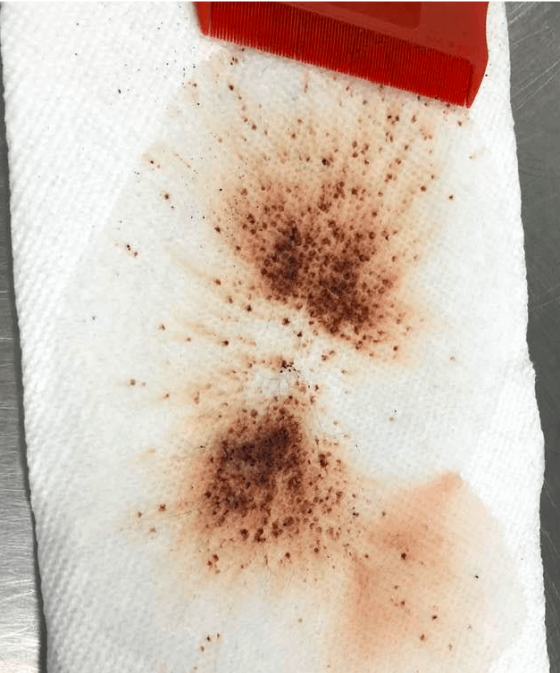
Treatment
If your cat has fleas, prompt and thorough treatment is essential. Unfortunately, eliminating fleas is not as simple as giving flea prevention your cat. You need to treat your home as well as your cat, and any other pets in the household. The primary steps are outlined below:
1. Treat your cat
Immediate treatment with a vet-recommended flea product is vital. There are a number of different types of flea treatments in Australia, including spot-on treatments, tablets, and collars. Some are stronger flea killers than others.
Our top recommendations for active flea burdens are Bravecto, Revolution Plus, Seresto, and Nexgard.
Read more in our article How To Treat A Cat With Fleas
2. Treat the Environment
Flea eggs, larvae, pupae and adult fleas will drop off your pet into other areas of your home. Materials like bedding, toys and carpet are ideal living areas for the flea family. If your cat is suffering from fleas, about 95% of the total flea problem is likely to be in your house rather than on your cat.
Treating the environment, as well as your pet, will wipe out the infestation much quicker. Gather all of your pet's bedding and material toys and place them in your washing machine on a hot wash with washing detergent. If you have a dryer, putting them on a hot drying cycle is also recommended. A thorough vacuum or steam clean of carpets and rugs is also important, focusing particularly around the areas where your cat sleeps, and also behind and under furniture.
3. Treat your other pets
If you own multiple pets, each pet should be given a flea treatment, preferably one with a monthly or longer protection. For dogs, products that kill fleas include Bravecto, Nexgard, Simparica, and Seresto. For information about flea prevention for dogs, consult our guide How to Treat Your Dog for Fleas.
Our Top Flea Products for Cats
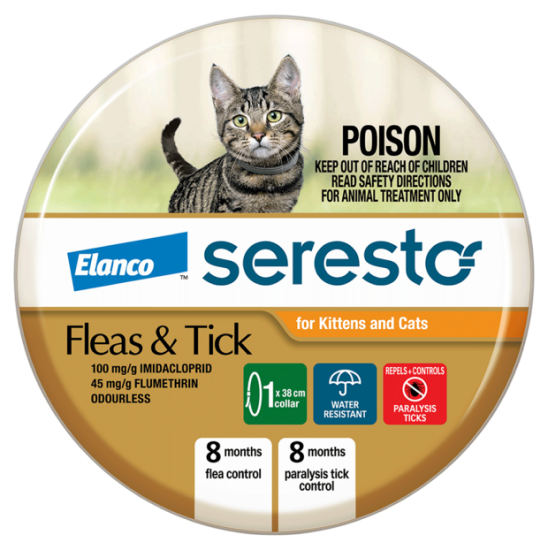
For a complete comparison table of all flea and tick products and which critters they cover, see our Comparison Table of Cat Flea Prevention in Australia.
Does bathing cats kill fleas?
Bathing cats to kill fleas is not recommended as a first line treatment. It is not only stressful, but altogether ineffective at killing fleas. While fleas in other parts of the world might 'drown' from bathing, fleas in Australia are remarkably tough, and usually survive a bath. Also, bathing a cat can be incredibly stressful and difficult - and even dangerous! - so it's really not worth it.
If your cat tolerates it, bathing may help to remove the flea dirt and dead fleas after treatment with a vet-recommended oral or topical product. It may also help soothe inflamed skin if a medicated shampoo is used.
Do flea shampoos work?
Flea shampoos are not generally recommended as a first line treatment. Flea shampoos are considered a temporary treatment, and while they may be enticing due to their price, they may end up being more costly and ineffective in the long run. Shampoos will generally only kill the adult fleas on your pet on the day of use, without any ongoing protection. This means that the larvae and pupae in the environment will soon cause another infestation when they develop into adult fleas.
Plus, many people find that in Australia, flea shampoos aren't totally effective as our fleas are extremely tough and hardy down here! Many flea shampoo products are made in Europe or the USA, and are just not very effective against our Aussie critters.
Efficacy aside, flea shampoos may also be toxic to cats due to the inclusion of permethrins. (You might be surprised to hear that some flea shampoos labelled for cats still contain permethrins!) While permethrins may be safe when used in small amounts on cats, and if rinsed off thoroughly, they are toxic in high amounts. And sadly, high amounts can easily be ingested due to the feline tendency to groom themselves after a bath.
Does dog flea treatment work on cats?
NEVER use a dog flea product on your cat. Giving medications labelled for dogs to your cat can cause serious illness such as seizures or even death. Cats are not simply 'small dogs' - they have a completely different liver metabolism and lack the enzymes to metabolise many chemicals (this is also why paracetamol is safe for dogs but deadly for cats). An overdose can easily occur with cats or smaller animals.
The danger from dog flea products is linked to pyrethrins, a mix of six chemicals that is highly toxic to cats and also found naturally in some chyrsanthemum flowers. Pyrethroids are the synthetic derivatives of pyrethrins, and one type of pyrethroid is permethrin. Permethrin is a common ingredient in dog flea & tick products and is safe for dogs, but lethal to cats.
Permethrin is found in household insect sprays, as well as flea and tick products (particularly Advantix and some tick collars). Cats can ingest pyrethrin via oral, respiratory, and topical routes through the skin, and are often poisoned by grooming a family dog who has been treated.
Signs of permethrin poisoning in cats
- Excessive salivation or frothing at the mouth
- Seizures
- Vomiting
- Tremors / muscle twitching
- Abnormal breathing
- Lack of coordination and collapse
- Death if not treated immediately
How often should I flea my cat?
Both indoor and outdoor cats should be treated for fleas regularly and all year round. While some other parts of the world benefit from having flea-free seasons and treatment may only be required in spring and summer, most parts of Australia are affected by fleas all year long. (Lucky us!)
How often you treat your cat depends on the product you use. Most products require monthly treatment (such as Nexgard, Revolution, and Advocate), while some last for three months (eg Bravecto) or even eight months (eg Seresto).
If your cat is a kitten under 6 months of age, consult our New Kitten Guide for a complete schedule of flea treatments required in the first few months of life.
What to Expect After a Flea Treatment
How long does it take for flea treatments to kill fleas?
Every flea prevention product is different, and some kill fleas much quicker than others. Topical treatments tend to kill fleas within 12-48 hours, whereas oral treatments tends to work within the first 2-4 hours. Consult the individual product for specific information.
Why is my cat running around after flea treatment?
Many cats act a little panicky immediately after a topical flea treatment application, and run around or hide. This is likely just due to the sensation of the medication on their skin, as cats are very sensitive to this. Topical flea treatments typically contain ingredients that can feel cold, wet, or even slightly oily upon application. Additionally, the scent of the medication is unpleasant to them, prompting them to exhibit behaviours such as running around or rubbing against surfaces to remove or mask the odour.
If your cat is still acting strangely after an hour, or exhibits any other signs such as tremors, vocalising, or collapse, it's important to take them to a vet as soon as possible.
Is it bad if cat licks flea prevention?
While products made for cats won't kill your cat if they lick it, it can make them ill. After licking flea prevention off their coat, most cats experience salivation or frothing from the mouth - however if a large amount is ingested, vomiting or even seizures may occur.
For this reason, it's best to put your cat's topical flea treatment at the very top of the back of the neck, close to the skull, and ensure you part the fur to squeeze it on the skin rather than on top of the external fur layer. This should ensure your cat can't reach it with their tongue.
Can cats be allergic to flea treatments?
Allergies to flea prevention are not common, however adverse affects to the medication can occur in some instances. The type of adverse reaction can vary depending on the product, but the most common symptoms include:
Symptoms of Adverse Reactions to Flea Products in Cats
- Vomiting and regurgitation (may occur in up to 30% of cats after some oral treatments)
- Drooling or frothing at the mouth
- Seizures
- Inappetance or reduced appetite
If you observe any of these reactions after giving a flea prevention product, call your vet for further advice or take your pet in to your closest clinic.
For more information, consult our article about Adverse Reactions to Flea and Tick Products.
I treated my cat for fleas but they're still scratching. How soon can I give treatment? What else should I do?
If you've used a vet-recommended flea product (ie, not a flea shampoo or natural product), then all fleas that are currently on your cat should be dead within a few hours - but this may not stop the itching right away. Chronic flea burdens and excessive scratching can cause inflamed skin, and a secondary bacterial dermatitis is often present. This may require treatment at your vet, or at the very least, patience and time for the skin to recover after the flea burden is gone.
Another reason for your cat continuing to scratch is that you may have flea eggs in your carpet or furniture that are re-infecting your cat. You will need to complete a thorough 'flea clean' of your whole house (as described above), as flea eggs in the environment are a constant source of reinfection.
You should not give a second flea treatment until the next one is due - for example, in one month's time - unless your vet has advised otherwise.
Home Treatment and Prevention

Wash all bedding and vacuum thoroughly
Flea eggs, larvae, pupae and adult fleas will drop off your pet into other areas of your home. Materials like bedding, toys and carpet are ideal living areas for the flea family. If your cat is suffering from fleas, about 95% of the total flea problem is likely to be in your house rather than on your cat.
Treating the environment, as well as your pet, will wipe out the infestation much quicker. Gather all of your pet's bedding and material toys and place them in your washing machine on a hot wash with washing detergent. If you have a dryer, putting them on a hot drying cycle is also recommended. A thorough vacuum or steam clean of carpets and rugs is also important, focusing particularly around the areas where your cat sleeps, and also behind and under furniture.
Should I use a flea bomb?
Some people opt for flea bombs to help to kill the parasitic visitors in their home. If using any flea bomb or spray product, always be cautious to follow the directions closely and remove your cat from the area being treated for at least the minimum recommended time. It's particularly important to wipe down surfaces such as windowsills that your cat's feet may touch after using a flea bomb. Many environmental flea treatments, including flea bombs, can be highly toxic to cats.
Stay regular!
After cleaning your home, treating your cat with flea prevention regularly is vital to maintain a flea-free environment. Adult fleas lay eggs on your cat, which then fall off into the environment (your home). These eggs hatch into larvae, which develop into pupae and eventually emerge as adult fleas. Treating your cat regularly with flea preventatives interrupts this lifecycle by killing fleas at different stages, preventing them from reproducing and perpetuating the infestation.
What about natural flea treatments?
A quick google search will provide you with copious information about natural remedies for getting rid of fleas on your cat. Common remedies include vinegar, tea tree oil, essential oils, lemon juice, rosemary, and sulfur. But do any of these actually work?
Unfortunately, natural remedies are not effective in Australia for treating active flea burdens on your pet. It's not just the spiders that are big and scary down under - our fleas are also extremely hardy. The warm, humid climate, combined with extra resistant critters, means that something stronger than vinegar or lemon juice is required.
Diatomaceous Earth, however, is a natural remedy useful for keeping your home environment flea-free. This talc-like powder is made from silica, which is also in sand. While it's not recommended to place it directly on your cat, you can sprinkle some into carpets, furniture and bedding, let it sit for a few hours, and then vacuum it up.
Some natural flea products are toxic to cats
Be very careful with tea tree oil, as it can be toxic to cats when absorbed through the skin or ingested via grooming. Sulfur is also toxic if ingested, as well as some essential oils (particularly pennyroyal oil, which belongs to the mint family).
Try a flea collar instead
If you aren't comfortable using a topical or oral medication with your cat, or they don't seem to tolerate these products, our top recommendation is to opt for a flea collar. Unlike other types of products, flea collars stay on the outside of your cat and do not require your cat to ingest or absorb any chemicals. Seresto is incredibly effective at repelling fleas, has no scent or powder, and lasts for 8 months for flea control. It also repels ticks, which makes it perfect for outdoor cats in tropical areas.
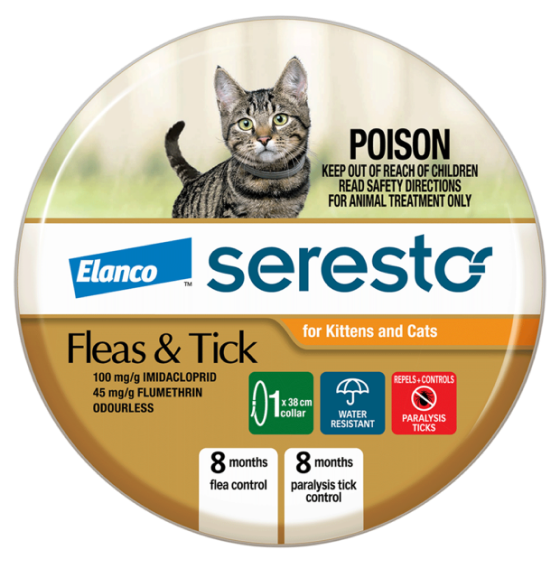
Conclusion
Keep your cat healthy and happy by keeping their flea treatments up to date all year around. Your family, and household, will benefit immensely from diligently treating against this common bloodsucking parasite, which has the potential to make everyone's life miserable.
Remember to always follow the label as directed when it comes to medication and flea bombs. For example, you must never use a dog flea medication on your cat unless it is approved by the manufacturer for use in both species.
For best results, treat the environment and any other pets you own. Using a flea treatment on your cat will eventually rid your house of fleas however depending on the severity of the infestation, this could take a couple of months.
FAQs
Can humans get fleas from cats?
Yes, humans can catch fleas from cats. While fleas have a preferred host, such as cats or dogs, they can bite and feed on humans if the opportunity arises. Fleas can jump onto humans when they come into contact with infested pets or environments.
Flea bites on humans typically result in small, itchy red bumps, similar to mosquito bites. In addition to the discomfort of the bites, fleas can also transmit diseases to humans, including murine typhus and cat scratch fever (caused by Bartonella bacteria). However, such transmissions are relatively rare.
Can pregnant and lactating cats be treated for fleas?
Flea and tick prevention should remain as per usual throughout your cat's pregnancy - provided your chosen preventative is safe for pregnancy.
Safe Flea Products for Pregnant Cats:
- Advantage
- Capstar
- Frontline Plus
- Neovela
- Nexgard Spectra
- Revolution (NB: not Revolution Plus)
Can Sphynx Cats get fleas?
Yes, Sphynx cats can get fleas just like any other breed of cat. Despite their lack of fur or having very short fur, Sphinx cats are not immune to flea infestations. Fleas can easily attach themselves to a Sphinx cat's skin and feed on their blood.
In fact, because Sphinx cats have less fur, fleas may be more visible on their skin, making it easier to detect an infestation. Additionally, because Sphinx cats have sensitive skin, flea bites can be particularly irritating and uncomfortable for them.
Further Reading
Want to know more? Check out our Discover Page for more tips from our expert vets on keeping your pets happy and healthy.